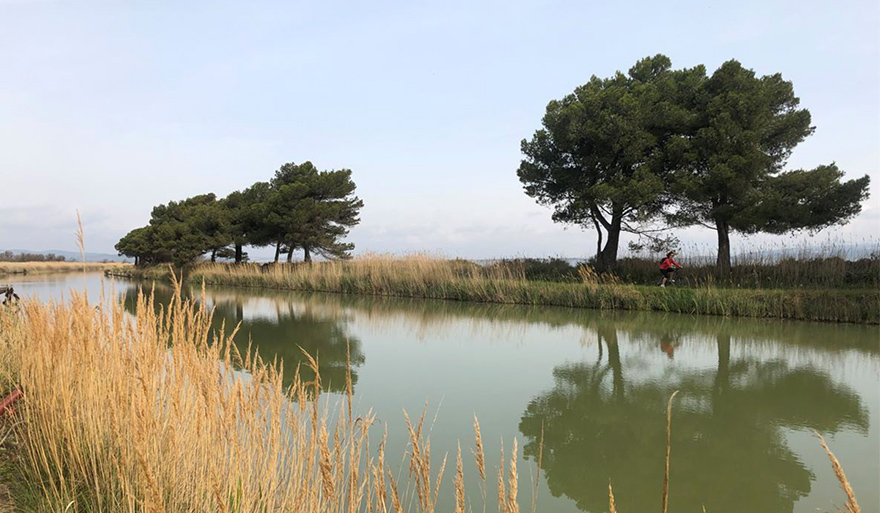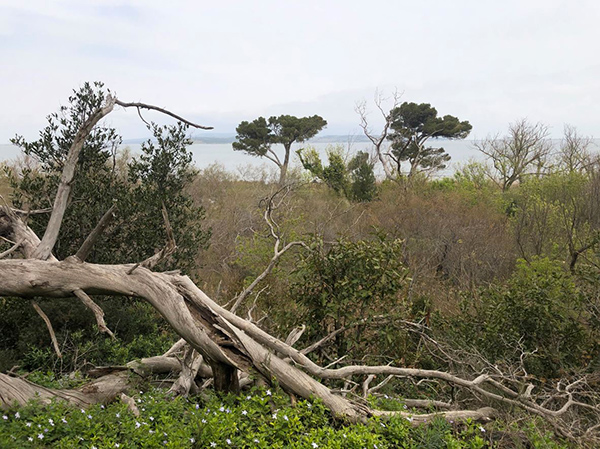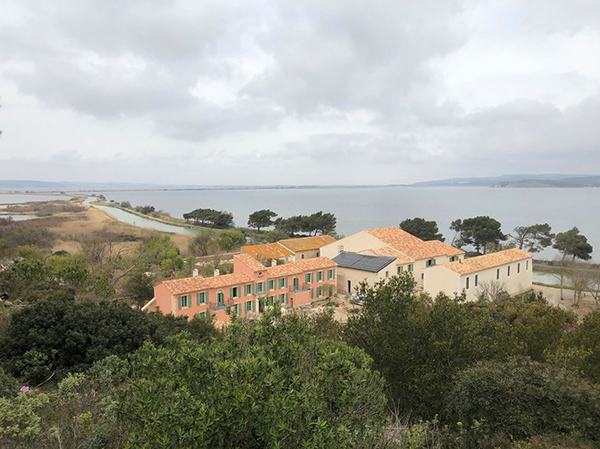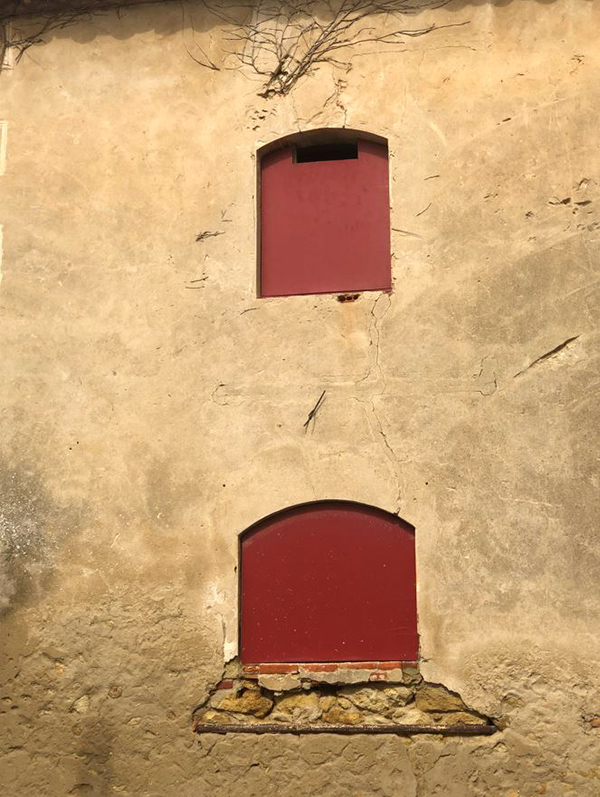How to reconcile tourism and simplicity? Ecotourism in action
Solar energy, shared accommodation, local materials... Everything has been carefully planned to enable basic tourism in a coastal refuge at the heart of a regional nature reserve.

Port-La-Nouvelle, Sainte-Lucie (France)
"Look over there, those are shelducks. They’re the only species of duck that lives in a saltwater environment." Claudine Loste, deputy shoreline manager with the Languedoc-Roussillon delegation of the Coastal Conservatory, is taking us on a tour. There are large stretches of water on either side of the track. We feel as if we are driving across the sea, but this is not the Mediterranean, even though it is very close: these are the Bages-Sigean and Ayrolle lagoons, in the department of Aude. The road that services the Montpellier-Barcelona railway line is taking us to the island of Sainte Lucie. Its verges have not been trimmed. The vegetation is high. There is no doubting that we are in a regional nature reserve.
On the banks of the Canal de la Robine, a UNESCO World Heritage site in the commune of Port-La-Nouvelle, stands an old agricultural estate, parts of which date from the 17th century. The building had fallen into serious disrepair through neglect, but in 2013 the Coastal Conservatory decided to save this piece of heritage and give it a new life. A four-year restoration project was begun, 50%-financed by the European Union's European Regional Development Fund (ERDF) and managed by the Occitanie region, as part of which the façade of the mansion was restored to its original pastel green and red. The result was a "magnificent empty shell", for which a new purpose had to be found before work on the interior renovation could begin.
From gîte to refuge
In 2016 the Coastal Conservatory and its partners agreed to develop the estate for ecotourism. More specifically, to accommodate tourists while at the same time respecting the environment and ensuring energy efficiency. An initial plan drawn up by a design office proposed turning the estate into a gîte offering guest rooms with guaranteed comfort at fairly high prices. "In order to be economically viable, it would have needed a lot of customers," says Claudine Loste. But accommodating such large numbers of people in a nature reserve would have entailed high energy consumption: "We didn’t want to disfigure the building by imposing particular functions or numbers of people on it for the purposes of profitability," she adds.
After a period of reflection that lasted from 2018 to 2019, it was finally agreed to turn it into a coastal refuge, a decision largely influenced by a visit to the Senetosa lighthouse refuge in Corsica, where hikers can eat and sleep for a night or two in simple comfort. "We said to ourselves, “This is what we’ll do!” It was a much better fit for our project," recalls Ms Loste. "This led us to redefine the project to be much simpler in terms of the comfort we were offering and the number of people we could accommodate." The target clientele is now different: nature lovers wanting to spend the day on the estate and perhaps spend a night there, at a cost of about 20 euros. Accessible only on foot or by bicycle, the estate will mainly serve walkers, hikers and cyclists using the EuroVelo 8 route that runs along the canal.

Simplicity as a choice
Workers are busy on the site, surrounded by bricks and heaps of gravel and sand. The interiors are still empty, but Claudine Loste can already picture how they will be: "This will be the kitchen, with a dining room where dinner will be served. This will be a small bicycle store, where electric bikes can be recharged if there is enough energy available." The refuge will only have limited amounts of electricity: it is connected to the mains water supply, but not to the electricity network. Its sole source of electricity will be solar panels, supplemented by a gas unit if necessary. So, in order to minimise energy consumption, there will be no freezer or dishwasher, only a refrigerator; nor will there be any heating in the shared dormitories, which will mean they can only be used during the summer season, between the Easter and All Saints' holidays.
For heritage architect Sylvie Rapp, one of the managers of the project, it is now "the building that is defining the use and not the use that is defining the alterations to the building". The philosophy is simple, yet it changes a lot. "For example, we didn't ask ourselves how many photovoltaic panels were needed to feed and wash thirty people; we asked ourselves how many panels we could put in without either making the building ugly or changing its character. And from there, we asked how many kilowatts we could generate and, based on that, how many people we could accept and at what level of service."

Ecological approach built in from the start
Photovoltaic panels are one of the few new materials used in the renovation – because planning for ecotourism begins with the construction site. "We’re using original and renewable materials. We’re working with Gard stone, which comes from the local region. The terracotta roof was made in Limoux [60 kilometres away as the crow flies]. And we’re mainly using terracotta for the floor, too," says Rapp.
In the garden of the estate a man is frantically slapping himself to avoid mosquito bites. Alain Bergé, a conservationist with the Sainte Lucie Regional Nature Reserve, has been assisting with the biodiversity aspects of the project from the very beginning. For example, tiny refuges have been installed as a new habitat for bats during the construction work. The Narbonnaise en Méditerranée Regional Nature Park is also responsible for assisting the future operators of the refuge with their training on biodiversity issues on the island, which attracts an average of 40,000 visitors per year.

Adapting to climate change
The entire project has been designed to be "simple, economical and, above all, adapted to our means: we don’t have a strong energy supply and we want to use as little water as possible," says Claudine Loste. Landscape architect Nathalie Silovy is also trying to build a basic hydrological system for the vegetable garden that she wants to recreate. "Since there is a natural water source, we are not going to use the town supply for watering. We’re going to re-route the water using gravity. It's a vernacular system, very similar to the way it would have been done originally," she says. Only plants that are adapted to the local environment will be used. "We're not going to be planting olive trees," she says: "There aren’t any olive groves round here. All the species we use must be adapted to periods of drought and flooding."
For the estate is in a flood zone, and this has had to be reflected in the specifications: the dormitories and living spaces have been placed on the upper floors, for example. The ecotourism approach must take the effects of climate change into account, especially since the forecasts for 2050 are not reassuring. According to data from Climate Central, the rise in water levels along the Narbonne coastline will eventually pose a threat to the Sainte Lucie estate. Until then, though, it will be possible to come and admire the flora and fauna of the nature reserve from this new refuge, which is expected to open in the spring of 2023.
 This article was produced as part of the Union Is Strength competition, organised by Slate.fr with the financial support of the European Union. The article reflects the views of the author and the European Commission cannot be held responsible for its content or use.
This article was produced as part of the Union Is Strength competition, organised by Slate.fr with the financial support of the European Union. The article reflects the views of the author and the European Commission cannot be held responsible for its content or use.